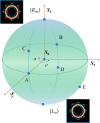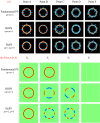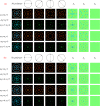Generation of concentric perfect Poincaré beams
- PMID: 31653873
- PMCID: PMC6814855
- DOI: 10.1038/s41598-019-50705-z
Generation of concentric perfect Poincaré beams
Abstract
We theoretically propose and experimentally verify a method to generate new polycyclic beams, namely concentric perfect Poincaré beams (CPPBs), by using an encoded annular phase mask. The proposed beams consisting of multiple polarization structured fields can be simultaneously generated in one concentric mode, which are respectively mapped by fundamental Poincaré sphere (PS), high-order Poincaré sphere (HOPS), and hybrid-order Poincaré sphere (HyPS). Moreover, the ring radius, numbers and polarization orders of the CPPBs at arbitrary positions on arbitrary PS are independently controlled. This work enriches the mode distributions of perfect vortex and introduces a new polarization degree of freedom, which has the potential to implement more information beyond the orbital angular momentum multiplexing in optical communication.
Conflict of interest statement
The authors declare no competing interests.
Figures







References
-
- Wang J, et al. Terabit free-space data transmission employing orbital angular momentum multiplexing. Nat. Photon. 2012;6:488–496. doi: 10.1038/nphoton.2012.138. - DOI
-
- Wang J. Advances in communications using optical vortices. Photon. Res. 2016;4:B14–B28. doi: 10.1364/PRJ.4.000B14. - DOI
-
- Wang J. Data information transfer using complex optical fields: a review and perspective. Chin. Opt. let. 2017;15:16–20. doi: 10.3788/COL201715.030005. - DOI
LinkOut - more resources
Full Text Sources

